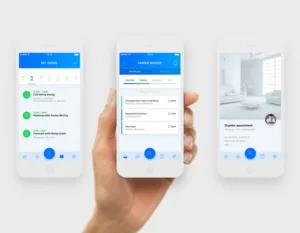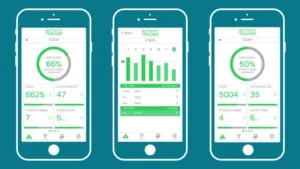Creating the UI of an app is a great challenge. It has to look good, feel good and make the user want to come back for more. Creating a great UI can be as simple as using colours that are different or shades of grey and choosing colours that are complementary (such as black and red). The user experience you want your app to offer should be created in mind while designing your app’s UI.
The way you position elements on the screen, how big they are, what information they display and how much they should promote usability should be considered thoughtfully during app design. When creating the UI for your Android application you should always think about what will work best in a particular environment — how fast do you want people to respond?
Will there be something worth waiting 10 seconds for? How much information do I want my users to process every time they use it? Well, worry not, we got your back!
[UI] User Interface
A user interface (UI) is a series of screens, pages, and visual elements—like buttons and icons—that enable a person to interact with a product or service. UI design is the process of creating a visual design language that represents the brand and message of an app or website.
The most basic type of UI is an application icon on your home screen which tells you what kind of app it is as well as its name. In addition to this, there could be small images in between each page while reading text in order to help guide users through their journey when they open up new windows after clicking on one particular link within another window (which we’ll get into later).
The UI is the series of screens, pages and visual elements—like buttons and icons—that enable a person to interact with a product or service.
For example, in an e-commerce website, when you’re shopping for clothes online you’re interacting with the user interface (UI). The screen that shows your options is called an “ad” (or advertisement) page because it’s designed to attract your attention and get you interested enough in buying something that you’ll click through to another page where they sell actual products.
UI Designing Principles
The user interface (UI) is the series of screens, pages, and visual elements—like buttons and icons—that enable a person to interact with a product or service. It’s also known as “user experience” or UX.
The design process starts with understanding your users’ needs, goals, expectations and pain points; then designing an experience that meets those needs by creating beautiful interfaces that are easy to use but still provide useful information when needed.

1. Clarity is the main principle.
Clarity is the main principle of UI design. UI design in apps and websites should be clear, simple, and easy to use. You can enhance your app’s usability by using elements that are easy to understand, such as buttons and text labels.
2. The second thing is consistency.
The second thing is consistency. Consistency is the key to a good design and it’s important for two reasons:
- It makes it easier for users to know what to expect from your app when they launch it. When you have consistent elements across all screens in your app, users can quickly learn how to use it without having to think about where one button goes next or where another one is located on the screen.
- Consistent designs also aid in usability by ensuring that there aren’t any surprises when interacting with an application—whether that be through a user interface (UI) or even via user input such as mouse movement or keyboard presses/typing behaviour (which we’ll talk more about below).
3. Easy navigation is the next thing.
The second step is to make sure that your navigation is simple and clear. Consistency is also important, so you should keep the same colour scheme across all pages of your app. This will help users find their way around easily without having to think about it too much.
In addition to making things easier for users, it’s also important that they remember how to use the app after using it once or twice. Navigation should be easy enough for someone who doesn’t know what they’re doing in an app yet!
4. Proper feedback to the user.
Feedback is important. The more frequent the feedback, the better. In fact, you should be providing both visual and audible feedback to your users so that they can see what’s going on as well as hear any instructions from you.
Visual cues will help guide them through their tasks and provide an added sense of control over their experience with your app; for example, when pressing a button in a mobile game (like Angry Birds), there might be an animation that shows how far into the next level they’ve gone or how many red pigs remain before reaching completion—these visual cues are very helpful in keeping players focused on the task at hand!
Audio messages can also play an important role in conveying information about what’s happening within an app without having to worry about looking away from its user interface (UI). If someone calls 911 while playing Call of Duty: Modern Warfare 2 then hearing “Your call has been answered” would certainly make them feel much better knowing help was nearby!
5. Simplicity is yet another principle.
Simplicity is an important principle in UI design. It’s one of the reasons why users feel a sense of comfort when they use your app or website, and it’s also what makes them want to come back again and again. So how do you create a simple design? The first thing you need to know is that simplicity isn’t just about removing clutter—it’s about making sure every feature has its own purpose.
A simple interface should be intuitive enough for anyone who uses it (even if they don’t understand all the details), but not so simple that any user can figure out how everything works without having some help from an expert user guide or tutorial video on how things work together on screen.
6. The next thing is efficiency.
You must make sure that the user can accomplish his task quickly and easily, while also making sure he has a good experience with your app. To do this, you have to consider how an app works as a whole and what parts are most important for achieving its purpose.
For example: if you’re building an app for restaurant food delivery services, then it wouldn’t make sense to include unnecessary features since those will just take up space on your users’ phones or slow them down when they open up the app.
In addition, you should also pay attention to how people use different types of apps (e.g., games vs utility apps). Some people might want their phones unlocked whenever possible; others may prefer privacy settings such as private mode so they don’t have any personal information displayed publicly online these preferences need consideration when designing interfaces within our products!

7. The last rule is flexibility and forgiveness.
The last principle of UI design is flexibility and forgiveness. This means that you should have a lot of options for your users to choose from, but also accept their decisions if they don’t make the right choice. For example, if your user wants to switch between two different keyboards on your app’s home screen then you want them to be able to do so without having any problems or confusion about which keyboard they should use at that time.
Similarly, if there are multiple accounts in one app (such as Facebook), then it’s important for them all to look similar so users know how each account works without having too many details displayed on the screen at once!
UI design has a very strong influence on user experience.
One of the most important things to understand about UI design is that it has a large influence on user experience. When you look at an app, you should be able to immediately tell what it does and how to use it. The first impression a person gets from your app should be positive—you want them to feel excited about using your product instead of frustrated or confused by its flaws.
One way designers can achieve this goal is by creating consistent visual elements throughout the entire application and making sure all interfaces work together as one thing instead of having separate sets of controls on each page (for example: if there are different types of buttons in two different places but they both do exactly the same thing).
You may also want some kind of consistency across screens within an app; for example, if one screen has checkboxes while another doesn’t then users won’t know where they’re supposed to check off items until they’ve already made those selections elsewhere*
Conclusion
It is important to understand how UI design works and what it needs from you. If you want to create a good UI, you need to know all the principles and rules of design. It can be very difficult at times, but with practice, you will get better at it!



















